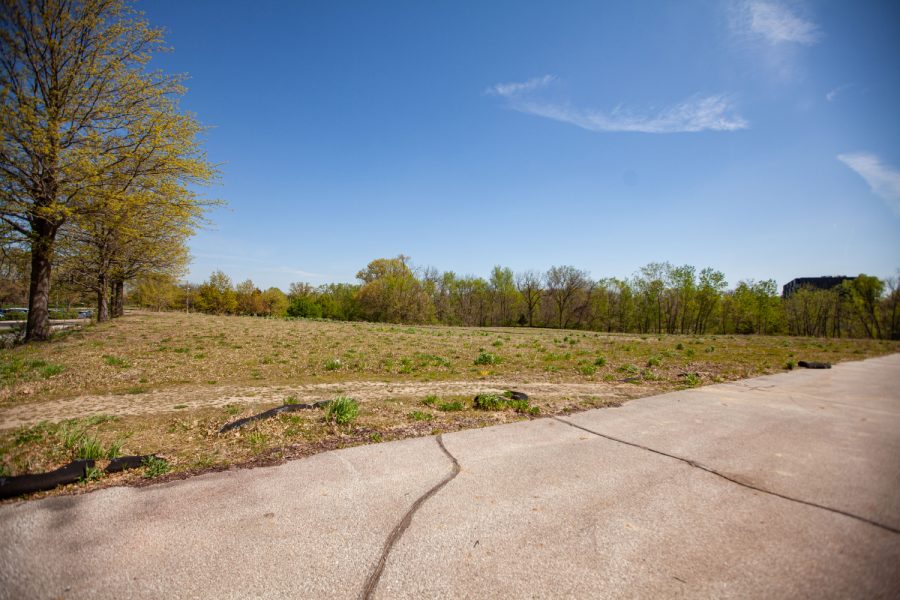Affordable housing advocates raise concern over new Finkbine development annexation
The City of Iowa City will annex a portion of University Heights land in order to pave the way for a new development to go in off the intersection of Finkbine and Melrose.
A piece of land located near the intersection of Finkbine Commuter Drive and Melrose Avenue as seen on Sunday, May 2, 2021. The land is being rezoned to make way for housing.
May 2, 2021
Iowa City City Council recently approved the rezoning and annexation of a plot of land in University Heights at the intersection of Finkbine Lane and Melrose Avenue which will soon be developed into higher-end housing for senior residents, near the Finkbine Golf Course.
Iowa City Senior Planner Anne Russett said because Iowa City is annexing a portion of University Heights land, this development had to be approved by the Iowa City City Council and the severance approved by the University Heights City Council.
Russett said this development will now go before the city development board this month, which is a state board that is responsible for reviewing annexations.
“The City of Iowa City and the City of University Heights have agreed and entered into what’s called a 28-year agreement, is just an agreement that outlines revenue sharing for taxes over the next several years,” Russett said.
Sara Barron, president of Johnson County Affordable Housing Coalition, raised concerns regarding the development and the affordability of the housing units included.
Barron said Iowa City established an affordable housing component to its annexation guidelines three years ago.
Despite the intention that the policy is to ensure 10 percent of housing units located on newly annexed land will be affordable for at least 20 years, Barron said the policy does not specifically acknowledge which types of annexations should not have that requirement.
“Staff indicated to the council that they didn’t believe that this particular annexation was a good fit for the policy,” Barron said. “Their reason for that was because rather than being a greenfield annexation, or in other words annexation of land that hasn’t already been developed, this was an infill project that they didn’t feel justified placing that requirement on it.”
Barron said in this particular annexation and development at Finkbine and Melrose, she thinks city staff and council should have considered ensuring affordable housing was included in the development.
“The city has acknowledged that it has relatively few tools at its disposal to require the provision of affordable housing,” Barron said. “They have lots of tools available to incentivize and to help people make housing that’s affordable, but they have very few opportunities to require development.”
For developments going in around Iowa City, developers have an option to include affordable housing units, or to pay a fee in lieu of the units to the city which will go towards the city’s affordable housing fund.
Barron said she thinks paying a fee in lieu can benefit the city’s long term affordable housing goals, as the city can better plan the location of affordable housing units and the lifespan of the affordability component as well.
“There’s some real benefit to having the developer pay the fee in lieu instead, if that fee in lieu gets spent on housing that is managed specifically with the goal of providing affordability,” Barron said.
Along with the benefits of the fee in lieu option, Barron said she thinks this provides opportunities that can be curated to best fit different types of families and income levels.
“I do think it makes sense to think longer term about dramatically increasing the overall number of units and the opportunities that are provided through those units, whether that be more choice about where people can live in the community affordably, whether that be a wider range of options for households of many different sizes and types,” Barron said.
After city staff presented the development during a council formal meeting on April 6, Councilor Pauline Taylor raised concerns regarding the development, referencing the city’s recent policy regarding annexation and affordable housing units.
“The annexation policy that we recently enacted, we’ve allegedly been told that this property doesn’t qualify for that affordable housing language and that’s concerning to me especially in light of the fact that, in general, most of the units that they spoke about, were on the higher end of the cost of units,” Taylor said. “So, I just have a lot of concerns about the actual project itself, but I’m in favor of annexation, it makes logical sense.”
Taylor also pointed out that the development will involve a large-scale tree removal, which she finds to be concerning as well.
“There’s one of the pages that talks about a grove of trees, and it said that 71.5 percent of the trees are planned to be removed,” Taylor said. “That’s a lot of trees, and at this time of climate action and the importance of people seeing the importance of trees, and our environment, that’s a lot of trees to be removed.”







